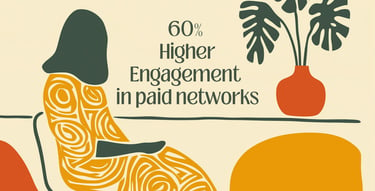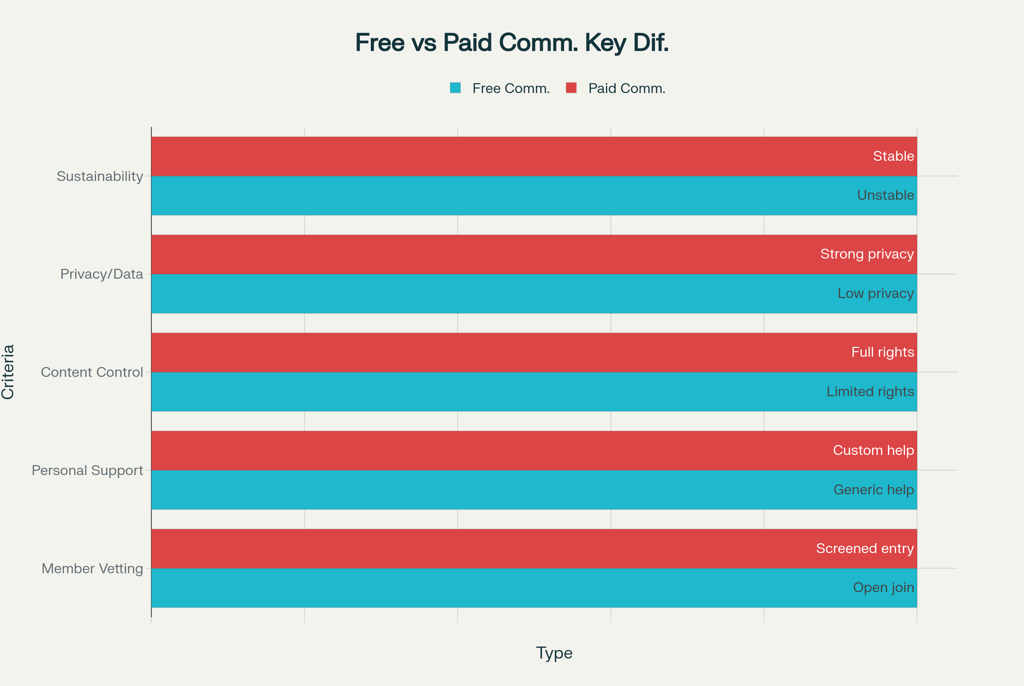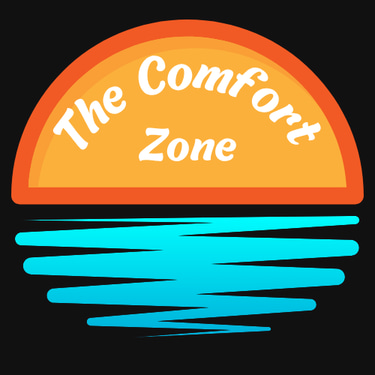Free vs. Paid Online Communities for Women Over 50
If you’re a woman over 50, finding genuine connection can feel harder than ever. Friendships shift, priorities change, and sometimes it feels like you’re navigating life’s biggest transitions alone. The good news? Online communities — both free and paid — can bridge that gap. But which one is right for you?
ARTICLES
Samantha I'Anson
8/12/20257 min read


Key Takeaways:
Women over 50 can benefit from dedicated online communities, offering connection, support, and shared experiences with peers in similar life stages
Free communities like Stitch provide valuable social connections and activities, but may have limitations in personalized support and quality control
Paid communities typically offer 60% higher member engagement and often focus on specific transitions or challenges relevant to women in midlife
The choice between free and paid communities depends on your specific needs, priorities, and the level of support you're seeking
In Your Comfort Zone provides specialized communities designed for women over 50 looking to connect with like-minded individuals in a supportive environment
Why Women Over 50 Need Dedicated Online Communities
You might have noticed that your social circle has changed. Friends moved away, retired, or became focused on different priorities. This experience isn't uncommon. Women over 50 often find themselves handling significant life transitions: retirement, empty nesting, caregiving for aging parents, or even processing loss and grief.
Dedicated online communities can provide a lifeline during these transitions. They create spaces where women can connect with others who understand their experiences without explanation. These communities foster belonging, combat isolation, and provide support through shared experiences unique to this life stage.
That's why spaces like In Your Comfort Zone have become so valuable - they offer women over 50 a dedicated place to find connection with peers who truly understand what they're experiencing. These communities offer more than just social connection - they provide practical resources, learning opportunities, and a place to find new interests with flexibility that works with diverse lifestyles.
Free Online Communities for Women Over 50
What Free Communities Typically Offer
Free online communities for women over 50 typically provide a variety of valuable features. Most offer discussion forums where members can exchange ideas, ask questions, and share experiences. Many include interest-based groups where women can connect around specific hobbies or topics like gardening, travel, or books.
Stitch, for example, is a community designed specifically for people over 50 seeking companionship. As noted on their website, Stitch is "built by members, for members" and offers local activities, events, online discussions, and even group travel opportunities. The community is supported by a small team and volunteer "Community Champions" located around the world. It is noted that although a limited free account is available, full participation and communication is an identity-vetted and paid for service.
Common Limitations of Free Communities
While free communities offer valuable connection opportunities, they do come with certain limitations. Resources are often stretched thin, which can mean less personalized support when you need it. This can be particularly challenging when handling sensitive topics or difficult life transitions that many women over 50 face.
Free communities sometimes struggle with maintaining consistent quality. Since there's no financial barrier to entry, these spaces may occasionally attract individuals who aren't genuinely interested in meaningful participation, which can dilute the community experience. I've seen this happen in several free groups where the conversation quality fluctuated dramatically from week to week.
Moderation may also be limited in free communities. Without funding for professional moderation, some free communities rely entirely on volunteers, like Stitch's Community Champions. While these volunteers are passionate and dedicated, volunteer-led moderation can sometimes lead to inconsistent enforcement of community guidelines.
When Free Communities Make the Most Sense
Despite these limitations, free communities can be an excellent choice in many circumstances. If you're just beginning to try online communities and aren't sure what you're looking for, free communities offer a low-risk way to test different groups until you find the right fit.
Free communities also make sense if your primary goal is casual connection. If you're looking for light social interaction and occasional participation rather than deep, transformative experiences, free communities can perfectly meet that need without unnecessary expense.
They're also ideal if you're on a fixed income, as many women over 50 are. Free communities provide access to social connection without adding financial strain, making them accessible to everyone regardless of economic situation.


Paid Online Communities for Women Over 50
The Higher Engagement Advantage (60% More Active Members)
Paid communities consistently demonstrate significantly higher engagement levels than their free counterparts. Data shows that paid networks typically have 60% more active members relative to total membership compared to free communities. This translates to more robust discussions, consistent participation, and a more vibrant community experience overall.
This higher engagement isn't coincidental. When members make a financial investment in a community, they're more motivated to extract value from that investment. This creates a positive cycle where increased participation enhances the community for everyone, leading to even greater engagement.
Member Quality and Value in Paid Spaces
Paid communities often excel at attracting high-value members. The financial commitment serves as a natural filter, tending to attract individuals who are serious about participation and contribution. In communities for women over 50, this often means connecting with peers who bring rich life experience, professional expertise, and thoughtful perspectives to discussions.
These communities typically invest more resources in vetting members as well. Many require application processes or interviews that help ensure alignment with community values and objectives. This additional layer of screening helps maintain a high-quality member base focused on authentic connection.
The result is often a more curated experience where you can connect with like-minded women who share similar values, objectives, and commitment levels. This selective approach tends to create deeper, more meaningful relationships among members.
How Paid Communities Support Life Transitions
One of the most significant strengths of paid communities for women over 50 is their ability to provide specialized support during important life transitions. The most successful paid communities recognize that many women in this age group are handling significant changes - whether it's retirement, empty nesting, career pivots, caring for aging parents, processing grief, or adjusting to health changes.
These communities often offer structured programs, workshops, or discussion groups specifically designed to address these transitions. Rather than generic content, you'll find resources tailored to the exact challenges and opportunities you're facing as a woman over 50.
The support is typically more personalized as well. Many paid communities offer smaller group experiences, one-on-one coaching, or mentorship opportunities that can provide individualized guidance through complex life changes. This level of personalized support is rarely available in free communities.
The 80% Member Contribution Factor
The most successful paid communities maintain a healthy balance between host-created content and member contributions. Data shows that thriving communities often achieve an 80% member contribution rate, meaning the vast majority of content and value comes from members themselves rather than community leaders.
This high level of member participation creates a self-sustaining ecosystem where the community becomes increasingly valuable over time. As members share their wisdom, experiences, and perspectives, the collective knowledge base grows exponentially.
For women over 50, this means access to a rich repository of lived experience from peers who have handled similar challenges and opportunities. Whether you're seeking advice on health concerns, financial planning for retirement, or reimagining your identity in this new life phase, you can benefit from the collective wisdom of women who understand your journey.
Member accountability also tends to be higher in paid communities. Because there's a financial commitment involved, members typically approach their participation more seriously and thoughtfully, resulting in higher-quality interactions and more meaningful connections.
Key Differences That Matter
1. Member Vetting and Community Quality
One of the most significant differences between free and paid communities is the approach to member vetting. Free communities typically have minimal barriers to entry, welcoming virtually anyone who expresses interest. While this creates accessibility, it can sometimes lead to quality inconsistencies.
Paid communities, in contrast, often employ more rigorous vetting processes. This creates spaces where the conversation quality tends to be consistently higher, with members who are committed to meaningful participation.
2. Level of Personalized Support
The depth of support you receive varies dramatically between free and paid communities. Free communities typically offer peer support and general resources, which can be valuable but limited.
Paid communities often provide more individualized attention, with structured support systems, professional facilitation, and sometimes one-on-one guidance. This can be particularly valuable during challenging transitions.
3. Content Ownership and Control
In free communities, you typically have less control over your content and data. Many free platforms claim ownership of posted content and may use your information for advertising purposes.
Paid communities generally offer clearer policies around content ownership and more respectful approaches to member privacy and data.
4. Privacy and Data Protection
Free communities are often supported by advertising models that rely on collecting and using user data. This can result in less privacy and more exposure to marketing, ads and algorithms.
Paid communities, funded by member fees rather than advertising, typically offer stronger privacy protections and fewer concerns about data mining.
5. Long-Term Community Sustainability
Free communities often face sustainability challenges. Without reliable revenue streams, they may struggle to maintain quality over time or may eventually introduce fees or advertising to remain viable.
Paid communities, with their subscription-based model, can invest in continuous improvement and long-term planning, often resulting in more stable and consistently valuable experiences.


Making the Right Choice for Your Specific Needs
When deciding between free and paid communities, it's essential to be honest about your priorities and needs. If you're seeking casual connection and light social interaction, free communities like Stitch may perfectly meet your needs without unnecessary expense.
However, if you're handling significant life transitions, seeking deeper relationships, or wanting more structured support and higher-quality interactions, the investment in a paid community often proves worthwhile. The enhanced engagement (60% higher in paid communities), curated membership, and more personalized support can make a meaningful difference in your experience.
Consider starting with a free community to see what online connection feels like, then moving to a paid community when you identify specific needs or transitions where more structured support would benefit you. Many women find that a combination approach works well - participating in both types of communities for different purposes.
In Your Comfort Zone offers supportive communities designed specifically for women over 50 looking to connect with others handling similar life experiences.
If you’re ready to explore a paid, supportive space designed for women just like you, then start your journey here.
